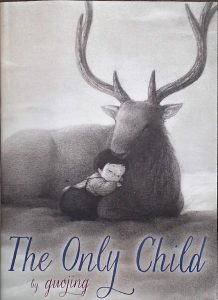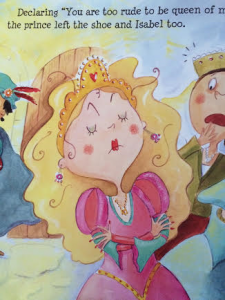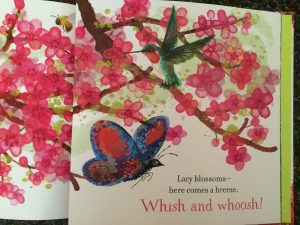
Author/Illustrator: Guojing
Publisher and Year: Schwartz & Wade Books, 2015
Number of Pages: 100
Genre: Fantasy/Fiction
 A lonely, only child runs away from home and finds a mysterious stag that takes her to a magical world. In this world, she feels loved and eventually misses home. Guojing takes us through the young girl’s journey back home to her family.
A lonely, only child runs away from home and finds a mysterious stag that takes her to a magical world. In this world, she feels loved and eventually misses home. Guojing takes us through the young girl’s journey back home to her family.
This book could serve as a mirror for those who can identify with the young girl. Some children may feel lonely and are only children, or at least feel as such. Children often use their imagination to “run away” to a place where they feel wanted and empowered. This story could also work as a window into the Chinese culture. The author has stated that this book “…reflects very real feelings of isolation and loneliness I experienced growing up in the 1980’s under the one-child policy in China” (P. 1). The longing for attention and love that a child feels is something that a multitude of readers can relate to.
There are no words in this book, as it is a picture narrative. Structurally, the entire story is told with pictures. For majority of the pages, the images are framed. There is no apparent pattern to the unframed images, but the reader feels more connected to those pages. The images are dark, which emphasizes the sadness the girl feels. The background to the images is more of a sepia when she is home and unhappy, but it is white when she runs away. This change in background emphasizes which images are happier than others. However, this story could just be a huge fantasy. When the child goes to bed, we see that she is holding what appears to be the stag that she rode to this mysterious land. Ideologically, this story shows readers that although it is very easy to become lost, there is always a path guiding the way back home. This story also conveys the idea that running away is an acceptable solution to feeling alone or abandoned. The parents of the child search helplessly for their lost child, but the child moseys on home like nothing happened.


 This dirty pigeon uses sarcasm and reverse psychology to get out of taking a bath. When his tactics don’t work and he is forced to take a bath, he realizes that baths aren’t so bad after all.
This dirty pigeon uses sarcasm and reverse psychology to get out of taking a bath. When his tactics don’t work and he is forced to take a bath, he realizes that baths aren’t so bad after all.![IMG_9670 [2578141]](https://blogs.iwu.edu/lrbmt2016/files/2016/05/IMG_9670-2578141-218x300.jpg)
![IMG_9671 [2578142]](https://blogs.iwu.edu/lrbmt2016/files/2016/05/IMG_9671-2578142-188x300.jpg) When an unwanted ghost boy, Leo, is “evicted” from his ghost home, he is forced to live on the streets. It isn’t until he meets a young, believing girl that he finally feels accepted and seen.
When an unwanted ghost boy, Leo, is “evicted” from his ghost home, he is forced to live on the streets. It isn’t until he meets a young, believing girl that he finally feels accepted and seen.![IMG_9673 [2578143]](https://blogs.iwu.edu/lrbmt2016/files/2016/05/IMG_9673-2578143-197x300.jpg)
![IMG_9675 [2578144]](https://blogs.iwu.edu/lrbmt2016/files/2016/05/IMG_9675-2578144-197x300.jpg) A rabbit is skeptical about what his new otter neighbors will be like. He is told to treat them as he would want them to treat him. After realizing how he’d like to be treated, he sees that maybe his new neighbors won’t be so bad after all.
A rabbit is skeptical about what his new otter neighbors will be like. He is told to treat them as he would want them to treat him. After realizing how he’d like to be treated, he sees that maybe his new neighbors won’t be so bad after all.![2016-05-16_16.28.25[1]](https://blogs.iwu.edu/lrbmt2016/files/2016/05/2016-05-16_16.28.251-300x298.jpg)
![2016-05-16_16.29.33[1]](https://blogs.iwu.edu/lrbmt2016/files/2016/05/2016-05-16_16.29.331-300x160.jpg)








![IMG_9614 [405971]](https://blogs.iwu.edu/lrbmt2016/files/2016/05/IMG_9614-405971-300x220.jpg)
![IMG_9615 [405972]](https://blogs.iwu.edu/lrbmt2016/files/2016/05/IMG_9615-405972-300x175.jpg)